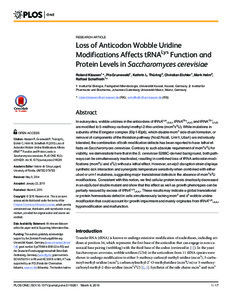| dc.date.accessioned | 2015-03-13T13:25:29Z | |
| dc.date.available | 2015-03-13T13:25:29Z | |
| dc.date.issued | 2015 | |
| dc.identifier.issn | 1932-6203 | |
| dc.identifier.uri | urn:nbn:de:hebis:34-2015031347703 | |
| dc.identifier.uri | http://hdl.handle.net/123456789/2015031347703 | |
| dc.description.sponsorship | Gefördert durch den Publikationsfonds der Universität Kassel | |
| dc.language.iso | eng | |
| dc.rights | Urheberrechtlich geschützt | |
| dc.rights.uri | https://rightsstatements.org/page/InC/1.0/ | |
| dc.subject.ddc | 570 | |
| dc.title | Loss of Anticodon Wobble Uridine Modifications Affects tRNALys Function and Protein Levels in Saccharomyces cerevisiae | eng |
| dc.type | Aufsatz | |
| dcterms.abstract | In eukaryotes, wobble uridines in the anticodons of tRNALysUUU, tRNAGluUUC and tRNAGlnUUG are modified to 5-methoxy-carbonyl-methyl-2-thio-uridine (mcm5s2U). While mutations in subunits of the Elongator complex (Elp1-Elp6), which disable mcm5 side chain formation, or removal of components of the thiolation pathway (Ncs2/Ncs6, Urm1, Uba4) are individually tolerated, the combination of both modification defects has been reported to have lethal effects on Saccharomyces cerevisiae. Contrary to such absolute requirement of mcm5s2U for viability, we demonstrate here that in the S. cerevisiae S288C-derived background, both pathways can be simultaneously inactivated, resulting in combined loss of tRNA anticodon modifications (mcm5U and s2U) without a lethal effect. However, an elp3 disruption strain displays synthetic sick interaction and synergistic temperature sensitivity when combined with either uba4 or urm1 mutations, suggesting major translational defects in the absence of mcm5s2U modifications. Consistent with this notion, we find cellular protein levels drastically decreased in an elp3uba4 double mutant and show that this effect as well as growth phenotypes can be partially rescued by excess of tRNALysUUU. These results may indicate a global translational or protein homeostasis defect in cells simultaneously lacking mcm5 and s2 wobble uridine modification that could account for growth impairment and mainly originates from tRNALysUUU hypomodification and malfunction. | eng |
| dcterms.accessRights | open access | |
| dcterms.bibliographicCitation | In: PLoS one. - Lawrence, Kan. : PLoS, 2015, 10 (3), e0119261, 1-17 | |
| dcterms.creator | Klassen, Roland | |
| dcterms.creator | Grunewald, Pia | |
| dcterms.creator | Thüring, Kathrin L. | |
| dcterms.creator | Eichler, Christian | |
| dcterms.creator | Helm, Mark | |
| dcterms.creator | Schaffrath, Raffael | |
| dc.relation.doi | doi:10.1371/journal.pone.0119261 | |

